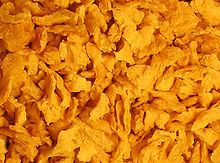Textured vegetable protein


Textured or texturized vegetable protein (TVP), also known as textured soy protein (TSP), soy meat, or soya chunks is a defatted soy flour product, a by-product of extracting soybean oil.[1] It is often used as a meat analogue or meat extender. It is quick to cook, with a protein content far greater than that which comes from meat.[2]
History
Textured vegetable protein was invented by the agricultural commodities and food processing company Archer Daniels Midland in the 1960s; the company owns the TVP name as a registered trademark.[3] Archer Daniels Midland had developed a textured soy protein isolate made with an extruder in the shape of rods or tubes. The soy protein isolate was produced in a small pilot plant and sold to one or two customers for use in chili, but the product was not commercially successful. In September 1965, Dwayne O. Andreas and his brother Lowell took over leadership of Archer Daniels Midland. The brothers possessed extensive experience in the soybean processing industry. Dwayne Andreas was greatly impressed with TVP and its potential. Although, at the time, TVP was being produced only in the company's laboratories, Andreas could envision a host of potential uses for TVP, ranging from a meat extender to a low-cost protein source in a wide variety of foods. Under Andreas's leadership, TVP use expanded in the U.S.; by 1968, it was widely used in a variety of food products, and consumption skyrocketed after 1971, when TVP was approved for use in school lunch programs. By 1980, similar products were being produced by rival companies in America, but Archer Daniels Midland remained the leader in TVP production.[4]
Manufacturing process
TVP is usually made from high (50%) soy protein soy flour or concentrate, but can also be made from cotton seeds, wheat, and oats. It is extruded into various shapes (chunks, flakes, nuggets, grains, and strips) and sizes, exiting the nozzle while still hot and expanding as it does so.[5] The defatted thermoplastic proteins are heated to 150–200°C, which denatures them into a fibrous, insoluble, porous network that can soak up as much as three times its weight in liquids. As the pressurized molten protein mixture exits the extruder, the sudden drop in pressure causes rapid expansion into a puffy solid that is then dried. As much as 50% protein when dry, TVP can be rehydrated at a 2:1 ratio, which drops the percentage of protein to an approximation of ground meat at 16%. TVP is primarily used as a meat substitute due to its very low cost at less than a third the price of ground beef, and when cooked together will help retain more weight from the meat by absorbing juices normally lost.[2]
Many TVP producers use hexane to separate soy fat from soy protein, and trace amounts of the solvent are left after manufacturing. But the few rodent studies that have been done suggest it would be almost impossible to get enough hexane from TVP to cause harm.[6] Measured levels of residual hexane in TVP are around 20 parts per million; and rodent studies suggest that a dosage of 5g/kg is the minimum level where adverse effects were observed. As such, one would have to consume around 250 kilograms of TVP per kilogram of body weight to reach a toxic dose.
Properties
TVP can be made from soy flour or concentrate, containing 50% and 70% soy protein, respectively; they have a mild beany flavor. Both require rehydration before use, sometimes with flavoring added in the same step. TVP is extruded, causing a change in the structure of the soy protein which results in a fibrous, spongy matrix, similar in texture to meat. In its dehydrated form, TVP has a shelf life of longer than a year, but will spoil within several days after being hydrated. In its flaked form, it can be used similarly to ground meat.
Uses
This section possibly contains original research. (July 2015) |
Textured vegetable protein is a versatile substance; different forms allow it to take on the texture of whatever ground meat it is substituting.[citation needed] Using TVP, one can make vegetarian or vegan versions of traditionally meat-based dishes, such as chili con carne, spaghetti bolognese, sloppy joes, tacos, burgers, or burritos.
Soy protein can also be used as a low cost/high nutrition extender in comminuted meat and poultry products, and in tuna salads.[7][8] Food service, retail and institutional (primarily school lunch and correctional) facilities regularly use such "extended" products. Extension may result in diminished flavor, but fat and cholesterol are reduced.
Textured vegetable protein can be found in natural food stores and larger supermarkets, usually in the bulk section. TVP is also very lightweight and is often used in backpacking recipes. Because of its relatively low cost, high protein content, and long shelf life, TVP is often used in prisons and schools, as well as for disaster preparedness.
See also
References
- ^ Riaz MN (2006). Soy applications in food. Boca Raton: CRC Press. pp. 155–84. ISBN 0-8493-2981-7.
- ^ a b Clark JD, Valentas KJ, Levine L (1991). Food processing operations and scale-up. New York: CRC Press. pp. 134–7. ISBN 0-8247-8279-8.
- ^ Decker, Fred. "Textured Vegetable Protein (TVP) vs. Textured Soy Protein (TSP)". NationalGeographic.com. p. 1. Retrieved May 20, 2013.
- ^ Shurtleff, William; Aoyagi, Akiko. "Archer Daniels Midland Company". Soy Info Center. p. 1. Retrieved May 19, 2013.
- ^ Foote R (1996). Food preparation and cooking. Cheltenham: Stanley Thornes. pp. 393. ISBN 0-7487-2566-0.
- ^ Brian Palmer (2010-04-26). "Is Your Veggie Burger Killing You?". Slate (magazine). Retrieved 2012-03-23.
- ^ Hoogenkamp, Henk W. (2005). Soy protein and formulated meat products. Wallingford, Oxon, UK: CABI Pub. ISBN 0-85199-864-X.
- ^ Joseph G. Endres (2001). Soy Protein Products. AOCS Publishing. ISBN 1-893997-27-8.
Further reading
- Shurtleff, William; Aoyagi, Akiko (2013). History of Soy Flour, Grits and Flakes (510 CE to 2013): Extensively Annotated Bibliography and Sourcebook (illustrated ed.). Soyinfo Center. ISBN 1928914632. Retrieved 24 April 2014.
{{cite book}}: Invalid|ref=harv(help)

